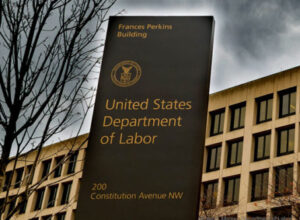 The federal Department of Labor (“DOL”) issued a final rule on Tuesday, November 22, allowing plan fiduciaries to consider climate change and other environmental, social and governance (“ESG”) characteristics when they choose investments and exercise shareholder rights, reversing a Trump-era rule that sought to constrain this type of risk analysis. ESG analysis can now be understood as squarely within the fiduciary obligations of a plan. The final rule comes at a time when investors are facing increasing financial risks due to climate change, and the amorphous category of “ESG investing” has come under increasing political attack from conservative policymakers.
The federal Department of Labor (“DOL”) issued a final rule on Tuesday, November 22, allowing plan fiduciaries to consider climate change and other environmental, social and governance (“ESG”) characteristics when they choose investments and exercise shareholder rights, reversing a Trump-era rule that sought to constrain this type of risk analysis. ESG analysis can now be understood as squarely within the fiduciary obligations of a plan. The final rule comes at a time when investors are facing increasing financial risks due to climate change, and the amorphous category of “ESG investing” has come under increasing political attack from conservative policymakers.
Regulatory Context
Over the last two decades, the DOL has issued several rules regarding whether and how fiduciaries may take ESG factors into account when making investment decisions that impact retirement plans under the Employee Retirement Income Security Act of 1974 (“ERISA”).
The tone of the DOL’s guidance has varied with different administrations. However, the DOL has consistently affirmed core principles of fiduciary duty: plan fiduciaries must make investment decisions in accordance with ERISA’s fiduciary duties of loyalty and prudence. This has always meant – and continues to mean – that ESG factors cannot be valued on noneconomic grounds, and must only be considered if they relate to financial investment criteria.
Nonetheless, in late 2020, the Trump-era DOL finalized rules entitled “Financial Factors in Selecting Plan Investments” that expressed skepticism as to whether ESG factors were compatible with ERISA. While those rules did not prohibit ESG consideration by ERISA fiduciaries, they specified that an ERISA fiduciary must focus only on a plan’s “pecuniary factors” in its investment decision-making process. The rules also prohibited plans from offering a default investment strategy that reflected “non-pecuniary” objectives in its investment strategy. ESG factors were not explicitly named in the rules, but the preamble expressed specific disapproval of ESG analysis. Many market participants viewed the tone of the preamble and related rules as a signal that ESG factors would be presumed to be non-pecuniary, and that the DOL was unlikely to approve of the consideration of ESG factors by ERISA fiduciaries.
In May 2021, President Biden issued Executive Order No. 14030 (“E.O. 14030”), on “Climate-Related Financial Risk”. The E.O. declares a new federal policy to “advance consistent, clear, intelligible, comparable, and accurate disclosure of climate-related financial risk […], including both physical and transition risks [and] act to mitigate that risk and its drivers[.]” Section 4 of E.O. 14030 directed the DOL to identify agency actions that can be taken to protect the life savings and pensions of U.S. workers and families from the threats of climate-related financial risk, and to consider publishing a proposed rule to suspend, revise, or rescind the 2020 Trump-era rules.
The DOL published a proposed rule on October 14, 2021 that addressed the intersection of ERISA fiduciary duties and ESG. The final rule, released on Tuesday, largely tracks the proposal.
The DOL Rule
The rule, “Prudence and Loyalty in Selecting Plan Investments and Exercising Shareholder Rights” (the “Rule”), is consistent with historical DOL guidance, and reiterates that “the duties of prudence and loyalty require ERISA plan fiduciaries to focus on relevant risk-return factors and not subordinate the interests of participants and beneficiaries […] to objectives unrelated to the provision of benefits under the plan.” However, the Rule also makes clear that ESG factors may have material value if they are relevant to risk assessment. While the Rule does not require the consideration of ESG factors in investment decision-making, it clarifies that investment decisions may – and perhaps should – include consideration of the economic effects of climate change and other ESG factors, if the fiduciary reasonably determines that the economic impacts of these factors are relevant to risk-return analyses.
The Rule makes clear that ERISA plan fiduciaries should consider material ESG factors like the financial risks of climate change in their investment decisions at two stages. First, as mentioned, a plan fiduciary may consider ESG factors in selecting an investment (or investment strategy) when they align with fiduciary obligations on risk assessment. That said, the Rule reiterates the long-standing requirement under ERISA that “a fiduciary may not subordinate the interests of the participants and beneficiaries in their retirement income or financial benefits under the plan to other objectives, and may not sacrifice investment return or take on additional investment risk to promote benefits or goals unrelated to interests of the participants and beneficiaries in their retirement income or financial benefits under the plan.” Accordingly, and as ever, the Rule maintains the absolute requirement that the plan fiduciary must choose the investment that best serves the financial interests of the plan.
Secondly, the Rule reinstates the principle underpinning the “all things being equal” standard, which formed the basis of earlier DOL guidance. This standard allows fiduciaries to make an investment decision based on the collateral benefits of ESG factors if – and only if – two investment choices equally serve the financial interests of the plan. This standard rescinds the 2020 Trump-era rule’s “tie-breaker” standard, which permitted a fiduciary to take into account collateral benefits only when two investment choices were otherwise “indistinguishable” with respect to risk and return. The Rule also rescinds a related documentation requirement: fiduciaries are no longer required to separately document their analysis if they rely on collateral benefits to break the tie. The DOL notes in the Rule that this requirement is not necessary, as “fiduciaries commonly document and maintain records about their investment selections as part of their general prudence obligation.”
Finally, the Rule rescinds the ESG-related prohibition regarding qualified default investment alternatives (“QDIA”): a fund that explicitly considers ESG factors is now permitted to be selected as a QDIA in a plan’s menu, provided it meets the standards set forth in existing QDIA regulations. This means that retirement plans may now select sustainable funds that use ESG criteria as the target-date funds offered as their default investment option. In the preamble to the Rule, the DOL reiterates the appropriate fiduciary obligations, stating that “QDIAs would continue to be subject to the same legal standards under the final rule as all other investments, including the prohibition against subordinating the interests of the participants and beneficiaries in their retirement income to other objectives.” The Rule also requires specific disclosure to plan participants regarding any collateral benefit characteristics of a QDIA, to the extent that a QDIA is selected on that basis.
Fiduciary Duty Standards in Conflict
The DOL’s new Rule addresses ESG both as a risk-assessment process and as a product. This dual function points to an important distinction: differentiating ESG as an analytical tool, and ESG as a product offering. One challenge with the evolving political discussion surrounding ESG investing is that the “ESG” acronym has come to function as something of a Rorschach test, shorthand for a wide range of actual and perceived investment practices.
Advocates argue that ESG factors are central to a financial evaluation of prospective investments, and function in service of fiduciary duty obligations. Regulators like the DOL and Securities Exchange Commission (“SEC”), as well as large swaths of the investment management community, use ESG analysis as a tool to further understand the financial investment risks associated with, for example, climate change or labor relations, all in furtherance of the goal to achieve value on behalf of investors. Conservative critics, however, complain that ESG masquerades as a political effort to advance progressive values.
Some states have passed “Anti-ESG” laws, which instruct state pension funds not to consider ESG factors in their risk assessments of investment opportunities, or which seek to punish companies that offer investment products that restrict funding to fossil fuel companies. (See here and here for examples.) These laws claim to emphasize fiduciary obligations to focus on pecuniary factors in investment decision-making – despite a growing body of evidence that ESG analysis leads to improved financial returns.
Amidst the ongoing debate about fiduciary duty and ESG principles, questions about federal preemption are likely to arise with respect to the DOL Rule’s impact on state Anti-ESG laws. It is important to understand that most state Anti-ESG laws cover public pension funds and retirement plans, which are explicitly not captured by the ERISA regulatory framework. Further, the new DOL Rule does not include explicit language on preemption of existing state law and regulation. Nevertheless, there is a good argument that the Rule preempts at least some state Anti-ESG laws. This is particularly likely for state laws that explicitly refer to ERISA fiduciary standards with respect to the management of public retirement plans.
The Supreme Court has held that in instances where state regulation “expressly references” ERISA, federal preemption should apply. In Mackey v. Lanier, 486 U.S. 825 (1988), a Georgia statute “expressly referred” to an ERISA benefit plan. In finding that the state statute was preempted by ERISA, the Court stated that “[t]he state statute’s express reference to ERISA plans suffices to bring it within the federal law’s [preemptive] reach.” Caution, however, that Mackey refers to 29 U.S.C. § 1144 (a), ERISA’s preemption provision, as its basis for preemption; and the plan at issue involved a private retirement plan, both of which are important to note because most Anti-ESG legislation does not exist within the same context. Still, the reasoning in Mackey could have significant implications for a number of the Anti-ESG laws that have been promulgated over the last year.
For example, several states expressly reference ERISA fiduciary standards in the handling of their public pension funds. The Florida Statutes, for example, explicitly provide that Florida’s State Board of Administration (“SBA”) is required “comply with the fiduciary standards set forth in [ERISA]” for decisions relating to the management of the Florida Retirement System Defined Benefit Pension Plan (“FRSDBP”). Yet the SBA approved a potentially-competing resolution on August 22, 2022. That resolution directs an update of the FRSDBP’s Investment Policy Statement to indicate that investment decisions must be based only on “pecuniary factors” – a clear stand against ESG investment considerations. Given the explicit deference set forth in the Florida Statutes, which requires the SBA to comply with ERISA fiduciary standards, the SBA Resolution may now be in conflict with the Rule.
In another state with recent Anti-ESG regulation, Kentucky, the Attorney General compared the fiduciary obligations of the Kentucky state pension fund with the ERISA fiduciary standards in a recent Opinion, dated May 26, 2022. That Opinion questioned “[w]hether ‘stakeholder capitalism’ and ‘environmental, social, and governance’ investment practices in connection with the investment of public pensions funds are consistent with Kentucky law governing fiduciary duties.” However, the Opinion also describes Kentucky’s fiduciary standards as “like ERISA.” This is arguably another instance of conflicting laws, at least with respect to the Opinion’s directive that state pension funds must shun ESG factors in their investment decision-making.
The cases of Florida and Kentucky illustrate that the demarcation between ERISA fiduciary duty and state pension fund investment management is not as clear as many believe. Stakeholders should evaluate their state’s statutory language, existing state and federal precedents regarding preemption, and previous administrative interpretations of public pension fund management principles, to determine whether a particular state Anti-ESG regulation may fail in the face of the new DOL Rule.






